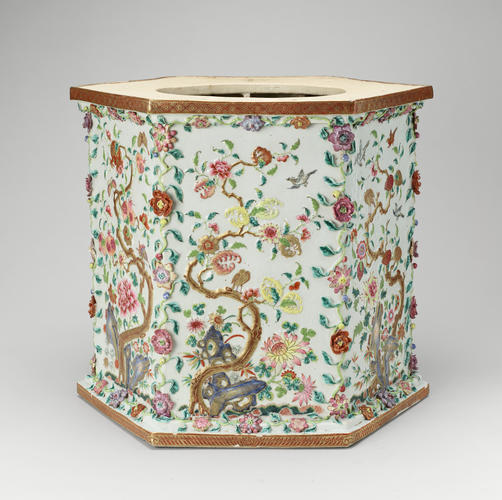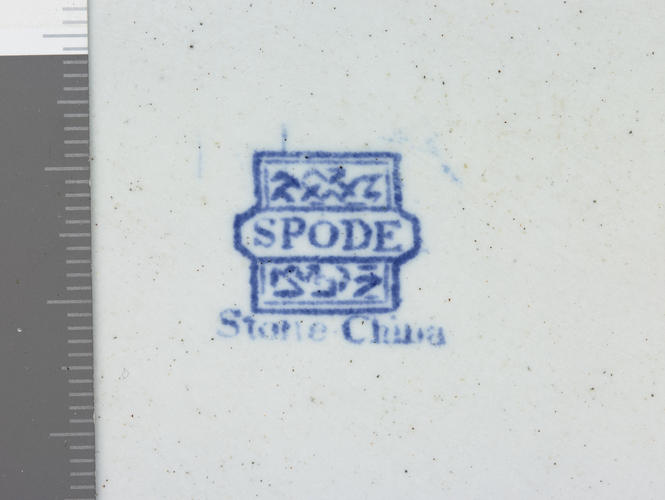Two pagodas pagodas: c.1800-3, mounts, c.1817–20
Porcelain painted in underglaze blue, famille rose enamel colours and gilt, with additions of gilt bronze and enamelled pottery | 212.4 x 95.2 cm (whole object) | RCIN 2400
-
The pagoda with eight hexagonal tiers, of which seven have separately modelled projecting tiled roofs with blue and gold ridges and upturned porcelain dolphins set at each corner, the topmost being a hexagonal dome through which rises a tall, gilt-bronze finial. It comprises a slender double-gourd vase, a hexagonal canopy with six hanging bells, a shaft with entwined serpent and an arrow piercing a winged dragon at the top, similar to that added to the larger pagodas, see RCIN 1. The roof eaves from which metal bells are suspended have been reinforced beneath with leaf-shaped gilt-bronze plates fixed with screws. Each tier has, alternately, three open doors leading into the interior and three blue-painted closed doors, the surrounds being decorated with moulded and painted flowers and pendants or, on alternate floors, with flowering trees and birds. Each is completed by an openwork balustrade of lotus plant design, having posts at the corners drilled for the insertion of gilt-bronze seated lions (now substitutes added in England). The bottom tier has one door only, flanked by a pair of painted guardian lions, the other five faces being decorated with moulded and painted sprays of hibiscus; it has no porcelain balcony and no roof, and its gallery is of gilt bronze in a pierced geometric pattern, with a vine-leaf and grape motif along its lower edge.
The entire pagoda has subsequently been set on a further hexagonal porcelain base of disproportionate height, which might appear to be alien to it, having a projecting lip and spreading foot, its sides decorated with moulded flowering trees and birds painted in a full famille rose palette, its corner edges having flower sprays with blooms in full relief. To counter the severity of the mismatch, a gilt-bronze balustrade was added in England to the projecting top rim. Additions were also made matching those of the larger pagodas (see RCIN 1), but on a reduced scale, to provide dolphins, hanging bells and ‘dogs’ (or lions) for the balustrades, with identical gilt-bronze projecting frames (R. Fogg, TNA LC 11/29, bill 5 April 1820): ‘16 ins [40.6 cm] diameter[?]’, also ‘36 large leaves richly chased and gilt for the shades’, and 48 in two lesser sizes, evidently for the reinforcement of the corner eaves. Bases applied with Spodeware panels were again added, but whereas the blue-and-white surrounds were enamelled at the corners with stridently red blooms, these were deliberately concealed beneath gilt-bronze sunflowers. The foot of the base with two rows of panelled mouldings: the uppermost found on see RCIN 1 and of the triangle and half-roundel pattern; the lower moulding with stylised leaf pattern, on a blue/grey scagliola plinth.Text adapted from Chinese and Japanese Works of Art in the Collection of Her Majesty The Queen: Volume II.
The Vulliamy family specialised in making and repairing clocks. From the 1790s, they produced bronze and gilt bronze objects of the highest quality. Often their role would be one of assembling parts made by different craftsmen, some of whom were directly employed by the family firm.Provenance
Two large pagodas & two lesser brought from China in 1804 by Dr J.J.Garrett; 'two extra large, elegant China pagodas nine feet high - £210' & '2 Do. Do.'It would appear that these are the 2 smaller pagodas brought back by Garrett from China
-
Creator(s)
(nationality)(metalworker)(porcelain manufacturer)Acquirer(s)
-
Medium and techniques
Porcelain painted in underglaze blue, famille rose enamel colours and gilt, with additions of gilt bronze and enamelled pottery
Measurements
212.4 x 95.2 cm (whole object)
Category
Object type(s)
Other number(s)














